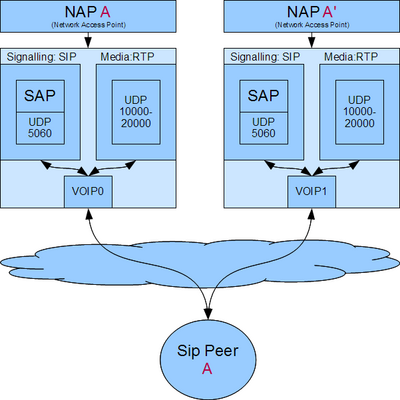Voip Redundancy
Redundancy of both RTP and SIP can be achieved by configuring one NAP per VoIP interface for a specific remote proxy.
Contents |
Signaling Redundancy
In the above example, we have configured two NAP Network Access Point that reaches the same SIP destination. In the event the ethernet interface VOIP0 went down, the NAP A would become unavailable, and thus routing would take place using NAP A'.
Media Redundancy
The NAP is also associated to the media by assigning an UDP port range for the RTP. When NAP is unavailable at the signaling level, the assigned RTP ports aren't being used either. In the above example, if the NAP A signaling is down, then all new outgoing calls would then be using VOIP1 ethernet interface for RTP.
Routing
To enable redundancy, we have to instruct the routing engine about the alternate route. This accomplish by creating a route for a specific destination using NAP A, and another route, for the exact same destination using NAP A'.
All routes using unavailable NAPs are ignored when routing takes place. So if NAP A is not available, then the route using NAP A' will be used to route the call to the specific destination.
NAP availability is a feature of Scriptable Routing Engine.
NAP
On the VoIP side, we normally have one NAP per remote sip proxy. On a configuration where VoIP redundancy is used, we have two NAPs, one for each VoIP ethernet interface.
Routes
Since the number of NAPs is double for a peer SIP proxy, then the number of routes mays also be doubled.
